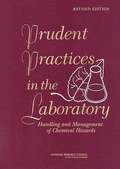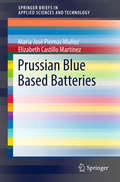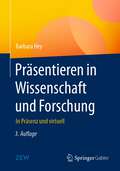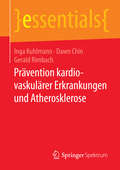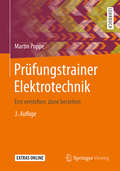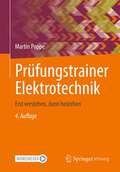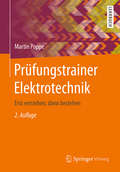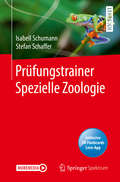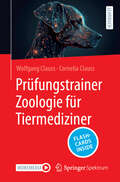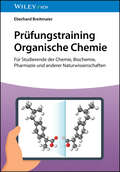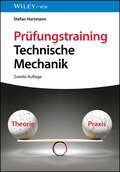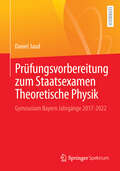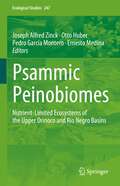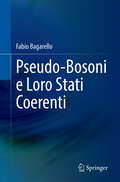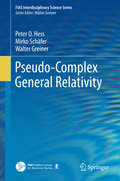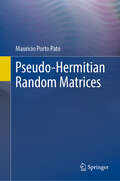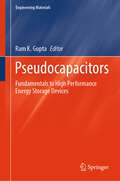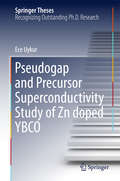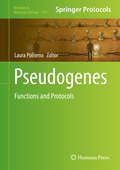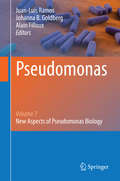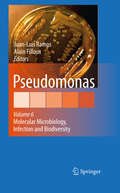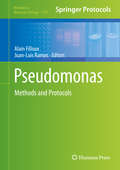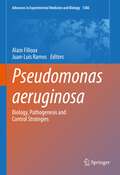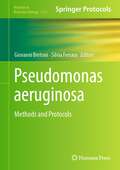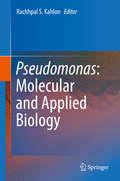- Table View
- List View
Prudent Practices in the Laboratory
by The National Academy of SciencesThe National Research Council published two guides during the early 1980s, updated and combined them in 1995, and in 2007 began the process of creating a new edition. Throughout its history, the reference has been intended to be useful to laboratory workers and managers, but also to help inform regulatory policy. Among the topics are the culture of laboratory safety, emergency planning, managing chemicals, working with laboratory equipment, laboratory security, and relevant safety laws and standards. The accompanying disk contains supplemental materials such as a sample incident report form, and procedures for the laboratory-scale treatment of surplus and waste chemicals. Annotation ©2011 Book News, Inc. , Portland, OR (booknews. com)
Prussian Blue Based Batteries (SpringerBriefs in Applied Sciences and Technology)
by María José Piernas Muñoz Elizabeth Castillo MartínezThis book reviews the structure and composition of Prussian Blue materials. It presents the state-of-the-art of their application to metal-ion batteries, highlighting the benefits derived from the integration of electrochemical energy storage with clean energies. It concludes with future perspectives including prototyping and large-scale production.
Präsentieren in Wissenschaft und Forschung: In Präsenz und virtuell
by Barbara HeyDer Vortrag ist für Forscher die Visitenkarte. Er bietet die Möglichkeit, Forschungsergebnisse, Arbeitsweise und sich selbst einem größeren Publikum vorzustellen. Im Wettbewerb um Noten, Stellen und Forschungsgelder reicht inhaltliche Exzellenz allein nicht aus, auch die Form muss stimmen. Das Buch geht auf die Bedürfnisse von Wissenschaftlern ein und vermittelt anschaulich, worauf in den einzelnen Phasen eines Vortrags zu achten ist. Mit diesen Hilfestellungen lassen sich ein eigener Vortragsstil, persönliche Sicherheit und Souveränität entwickeln.
Prävention kardiovaskulärer Erkrankungen und Atherosklerose (essentials)
by Gerald Rimbach Inga Kuhlmann Dawn ChinInga Kuhlmann, Dawn Chin und Gerald Rimbach geben eine Einführung zu Stickstoffmonoxid-Synthasen und deren Bedeutung in der Prävention und Pathogenese kardiovaskulärer Erkrankungen. Außerdem liefern sie einen Überblick zu Apolipoprotein E und dessen Bedeutung in der Entwicklung einer Atherosklerose. Die Autoren geben abschließend Empfehlungen für eine gesunde Ernährung zur Prävention von Herz-Kreislauf-Erkrankungen.
Prüfungstrainer Elektrotechnik: Erst verstehen, dann bestehen
by Martin PoppeDieses Buch bereitet gezielt auf eine Prüfung vor dem Bachelor-Abschluss vor. Es enthält Antworten auf Prüfungsfragen, Lösungsstrategien für Klausuraufgaben und Begründungen der wesentlichen Gesetze der Elektrotechnik und Elektronik. Die Fragen sind nach Schwierigkeitsgrad geordnet. So können die Studierenden Lücken im eigenen Wissen finden und durch ein vertieftes Verständnis ersetzen. Über 300 Abbildungen helfen dem Verständnis und vollständig durchgerechnete aktuelle Praxisbeispiele veranschaulichen den Stoff.Die 3. Auflage wurde aktualisiert, vollständig überarbeitet und enthält nun zusätzlich zu den mehr als 200 Klausuraufgaben 160 neue Fragen aus mündlichen Prüfungen und verständlich begründete Antworten. Das Buch wendet sich an Studierende der Elektrotechnik im Haupt- oder Nebenfach, die sich gezielt auf eine Prüfung vor dem Bachelor-Abschluss vorbereiten wollen.
Prüfungstrainer Elektrotechnik: Erst verstehen, dann bestehen
by Martin PoppeDieses Buch soll helfen, Prüfungen auf dem Gebiet der Elektrotechnik zu bestehen. Die 4. Auflage wurde aktualisiert, vollständig überarbeitet und bietet den Zugang zu mehr als 300 elektronischen Karteikarten („Flash Cards“), mit deren Hilfe die Kenntnis elementarer elektrotechnischer Begriffe und Zusammenhänge gefestigt werden kann. Das Buch enthält 160 Fragen aus mündlichen Prüfungen und verständlich begründete Antworten sowie mehr als 200 nach Schwierigkeitsgrad geordnete Klausuraufgaben. Zu diesen Aufgaben werden ausführliche Lösungen vorgerechnet und Lösungsstrategien vermittelt.Zu jedem der acht Themengebiete werden in einem Theorieteil die grundlegenden Zusammenhänge erläutert. Über 300 Abbildungen helfen dem Verständnis und vollständig durchgerechnete aktuelle Praxisbeispiele veranschaulichen den Stoff.
Prüfungstrainer Elektrotechnik: Erst verstehen, dann bestehen
by Martin PoppeDieses Buch bereitet gezielt auf eine Prüfung vor dem Bachelor-Abschluss vor. Es enthält Antworten auf Prüfungsfragen, Lösungsstrategien für Klausuraufgaben und Begründungen der wesentlichen Gesetze der Elektrotechnik und Elektronik. Das Buch enthält zur Verdeutlichung der Lösungsstrategien mehr als 300 Abbildungen.Für die 2. Auflage neu aufgenommen wurden neben Feldberechnungen mit und ohne Magnetkreise auch diverse Praxisbeispiele und Details zum Verhalten von Leitungen.
Prüfungstrainer Spezielle Zoologie
by Isabell Schumann Stefan SchafferDieser Prüfungstrainer führt als roter Faden durch das komplexe Gebiet der Speziellen Zoologie mit einem Überblick über alle systematisch relevanten Tiergruppen. Anhand vieler Beispiele bietet dieses Buch eine Reise durch das gesamte Tierreich – von Protisten zu den Säugetieren – und greift dabei prüfungsrelevante Themen und Schwerpunkte sinnvoll auf. Körperbau, wichtige ökologische Funktionen und Verwandtschaften der Tiergruppen werden nicht nur in schlüssigen Beschreibungen und Erklärungen, sondern auch mit zahlreichen Abbildungen veranschaulicht. Durch die einheitliche Beschreibung systematisch relevanter Tiergruppen werden die komplexen und vielseitigen Inhalte der zoologischen Systematik zu einem prägnanten Basiswissen zusammengefasst. Mit zahlreichen Fragen und digitalen Karteikarten zur Wissensüberprüfung sowie freien Seiten für individuelle Notizen ist dieser Prüfungstrainer die beste Ausgangsbasis für den Einstieg in die vertiefende Literatur und den erfolgreichen Abschluss Ihrer Zoologie-Prüfung.
Prüfungstrainer Zoologie für Tiermediziner
by Wolfgang Clauss Cornelia ClaussDas zoologische Fachwissen für Studierende der Tiermedizin ist in diesem Prüfungstrainer kompakt dargestellt und auf die tierärztliche Vorprüfung zugeschnitten. Alle relevanten Themen der allgemeinen und speziellen Zoologie werden präsentiert und mit der jeweiligen tiermedizinischen Relevanz verknüpft. Prüfungsfragen zu jedem Kapitel und Themenkomplex ermöglichen eine optimale Vorbereitung. Zahlreiche Tabellen und farbige Illustrationen veranschaulichen den Lernstoff für die weitere tierärztliche Ausbildung und Tätigkeit. Digitale Karteikarten ermöglichen eine sichere Kontrolle der erlernten Inhalte und einen erfolgreichen Abschluss Ihrer Vorphysikumsprüfung.
Prüfungstraining Organische Chemie: Für Studierende der Chemie, Biochemie, Pharmazie und anderer Naturwissenschaften
by Eberhard BreitmaierDer ideale Begleiter für die Prüfungsvorbereitung im Fach Organische Chemie Für alle Studierenden der Chemie, Biochemie, Pharmazie und anderer Naturwissenschaften an Universitäten und Fachhochschulen gehören Vorlesungen der Organischen Chemie zu den Pflichtveranstaltungen und zum Prüfungsstoff. Dieser kompakte Prüfungstrainer basiert auf der umfangreichen Lehrerfahrung des Autors und präsentiert die Grundlagen der organischen Chemie in 86 kurzen, in sich geschlossenen Lerneinheiten, auf ein bis max. zwei Doppelseiten (Zweiseitenansicht). Eine Auswahl an Verständnisfragen am Ende jedes Kapitels und Antworten im Anhang ermöglichen eine effektive Selbstkontrolle und ideale Prüfungsvorbereitung. Ob für Studierende der Chemie, Biochemie, Pharmazie, Biologie – hier werden alle wesentlichen Themen kurz und verständlich erklärt: von Atomorbitalen über Hybridorbitale zu den Molekülorbitalen kovalenter Bindungen grundlegende Definitionen und Konzepte, wie Konstitution, Konformation, Konfiguration, Chiralität, Konjugation, Mesomerie, Aromatizität Verbindungsklassen und ihre Nomenklatur, einschließlich Naturstoffe, Polymere und Biopolymere Organische Reaktionen (Typen, Mechanismen, Selektivität und Spezifität) Molekülstruktur (kurze Einführung in die Strategie der Aufklärung durch Massenspektrometrie, Lichtabsorptions-, IR- und NMR-Spektroskopie) Planung organischer Synthesen Damit ist das Prüfungstraining Organische Chemie ein unverzichtbares Repetitorium für Studierende mit den Studienabschlüssen Bachelor, Master und Staatsexamen, die ihr Wissen in der Organischen Chemie festigen wollen, um die Prüfung gut zu bestehen.
Prüfungstraining Technische Mechanik
by Stefan HartmannMit „Prüfungstraining Technische Mechanik“ von Stefan Hartmann braucht man vor Klausuren und Prüfungen nicht mehr zu zittern. Mehr als 250 Aufgaben mit ausführlich durchgerechneten Lösungen aus allen Themengebieten der Technischen Mechanik – Statik, Elastostatik, Kinematik und Dynamik – helfen beim Verstehen und Vertiefen der Lerninhalte. Unerlässlich für Studierende in Ingenieurstudiengängen wie Maschinenbau, Verfahrenstechnik und Bauwesen: Insbesondere zusammen mit dem Lehrbuch „Technische Mechanik“ legt das Prüfungstraining die Grundlagen fürs weiterführende Studium.
Prüfungsvorbereitung zum Staatsexamen Theoretische Physik: Gymnasium Bayern Jahrgänge 2017-2022
by Daniel JaudDieses Lehrbuch beinhaltet die Examensaufgaben und Lösungsvorschläge zur theoretischen Physik für das Lehramt an Gymnasien in Bayern. Da das Rechnen von Aufgaben eine zentrale Prüfungsvorbereitung darstellt, stehen in diesem Buch ausgearbeitete Lösungen zur Verfügung, um einen maximalen Lernerfolg zu erzeugen. Zusätzlich liefert das Buch zu Beginn ein kurzes Repetitorium zu allen vier großen Themenbereichen, welche im Staatsexamen geprüft werden: die klassische Mechanik, die Elektrodynamik, die Thermodynamik und statistische Physik sowie die Quantenmechanik. Das Repetitorium zu den einzelnen Themenbereichen ist dabei so gestaltet, dass nur die absolut prüfungsrelevanten Kenntnisse nochmals aufgefrischt, wiederholt und an wichtigen exemplarischen Beispielen illustriert werden. Damit liefert dieser erste Teil des Buches eine kompakte Wissenszusammenfassung aller wesentlichen theoretischen Konzepte, welche im Staatsexamen beherrscht werden sollten. Der zweite Teil des Buches mit über 96 Prüfungsangaben und ausgearbeiteten Lösungen stellt eine der umfangreichsten Sammlungen zum Staatsexamen in der theoretischen Physik dar. Dadurch, dass sich die Lösungen gleich im Anschluss zur entsprechenden Aufgabe befinden, wird es Leserinnen und Lesern ermöglicht, schnell eigene Ergebnisse beim Durcharbeiten der Aufgaben zu überprüfen und wichtige Erkenntnisse zu erlangen.
Psammic Peinobiomes: Nutrient-Limited Ecosystems of the Upper Orinoco and Rio Negro Basins (Ecological Studies #247)
by Joseph Alfred Zinck Otto Huber Ernesto Medina Pedro García MonteroThe book represents a multidisciplinary approach to understanding soil–landscape–vegetation relationships and, specifically, the ecophysiology of plant communities developing on sandy soils of very low fertility that are subject to seasonal flooding. It provides an overview of the white sand ecosystems within the Amazon basin, and focuses on the forest and herbaceous (meadows) vegetation growing on the dystrophic sandy soils of the upper Negro and Orinoco river basins. Several chapters describe physiographic aspects of the study area using integrated remote sensing and in situ sampling. By doing so they attain a comprehensive description of the origin and evolution of soils and landscapes, an advanced classification of soils, and a mapping of the geographic distribution of psammophilous vegetation. This volume also provides a phytosociological classification of extensive forested areas, and a detailed description of the structure and diversity of little-known herbaceous formations.It targets professionals in the fields of ecology, ecophysiology, geomorphology, soils, vegetation, and the environmental sciences. The information it offers may be of significant use to researchers, protected area planners, and environmental policy makers.
Pseudo-Bosoni e Loro Stati Coerenti
by Fabio BagarelloL'analisi proposta in questo libro si focalizza su particolari deformazioni delle regole di commutazione canoniche suggerite dal recente, e sempre crescente, interesse per la meccanica quantistica PT-simmetrica. Se ne considerano diverse conseguenze di natura matematica, ma anche loro possibili applicazioni alla fisica. Queste includono l'analisi di diverse Hamiltoniane non autoaggiunte, il calcolo di integrali di cammino associati a tali Hamiltoniane per mezzo di stati bi-coerenti, ed una nuovo punto di vista sugli operatori posizione e momento. Il libro è prevalentemente destinato ai ricercatori ma è anche pensato per essere fruibile da studenti di magistrale e di dottorato. Fornisce inoltre una introduzione ad alcuni aspetti delicati dell'analisi funzionale e della meccanica quantistica per osservabili non autoaggiunte.
Pseudo-Complex General Relativity
by Walter Greiner Peter O. Hess Mirko SchäferThis book explores the role of singularities in general relativity (GR): The theory predicts that when a sufficient large mass collapses, no known force is able to stop it until all mass is concentrated at a point. The question arises, whether an acceptable physical theory should have a singularity, not even a coordinate singularity. The appearance of a singularity shows the limitations of the theory. In GR this limitation is the strong gravitational force acting near and at a super-massive concentration of a central mass. First, a historical overview is given, on former attempts to extend GR (which includes Einstein himself), all with distinct motivations. It will be shown that the only possible algebraic extension is to introduce pseudo-complex (pc) coordinates, otherwise for weak gravitational fields non-physical ghost solutions appear. Thus, the need to use pc-variables. We will see, that the theory contains a minimal length, with important consequences. After that, the pc-GR is formulated and compared to the former attempts. A new variational principle is introduced, which requires in the Einstein equations an additional contribution. Alternatively, the standard variational principle can be applied, but one has to introduce a constraint with the same former results. The additional contribution will be associated to vacuum fluctuation, whose dependence on the radial distance can be approximately obtained, using semi-classical Quantum Mechanics. The main point is that pc-GR predicts that mass not only curves the space but also changes the vacuum structure of the space itself. In the following chapters, the minimal length will be set to zero, due to its smallness. Nevertheless, the pc-GR will keep a remnant of the pc-description, namely that the appearance of a term, which we may call "dark energy", is inevitable. The first application will be discussed in chapter 3, namely solutions of central mass distributions. For a non-rotating massive object it is the pc-Schwarzschild solution, for a rotating massive object the pc-Kerr solution and for a charged massive object it will be the Reissner-Nordström solution. This chapter serves to become familiar on how to resolve problems in pc-GR and on how to interpret the results. One of the main consequences is, that we can eliminate the event horizon and thus there will be no black holes. The huge massive objects in the center of nearly any galaxy and the so-called galactic black holes are within pc-GR still there, but with the absence of an event horizon! Chapter 4 gives another application of the theory, namely the Robertson-Walker solution, which we use to model different outcomes of the evolution of the universe. Finally the capability of this theory to predict new phenomena is illustrated.
Pseudo-Hermitian Random Matrices
by Mauricio Porto PatoThis book is a comprehensive guide to pseudo-Hermitian random matrices, their properties, and their role in many models that are relevant to physical processes. The book starts by showing how the concept of pseudo-Hermiticity emerged from studies of PT-symmetric systems which aroused the interest of the random matrix theory community. The chapters that follow discuss the consequences of the pseudo-Hermitian condition to the eigen-decomposition of non-Hermitian matrices, and an investigation of pseudo-Hermitian random matrices in tridiagonal form, discussing the scenario with real eigenvalues, and the appearance of complex eigenvalues generated by unbound and non-positive metrics. Subsequently, the author introduces pseudo-Hermitian Gaussian matrices and their properties including characteristic polynomials, and statistical properties of their eigenvalues. Finally, in the last chapter, the time invariance of the metric is upended and a pseudo-Hermitian model with a time dependent metricis constructed to discuss the time evolution of entangled states.
Pseudocapacitors: Fundamentals to High Performance Energy Storage Devices (Engineering Materials)
by Ram K. GuptaThis book provides an overview of pseudocapacitive materials, including their fundamentals, synthetic methods, architectural enhancements to boost their properties, and emerging materials. It covers numerous strategies to enhance their performance, such as altering morphology, doping, introducing multivalent ions, designing devices, and utilizing emerging pseudocapacitive materials. The book also delves into fundamental approaches for fine-tuning the properties of pseudocapacitive materials and explores their applications in energy storage devices, with a specific focus on emerging pseudocapacitive materials and their utilization in energy storage devices.
Pseudogap and Precursor Superconductivity Study of Zn doped YBCO
by Ece UykurIn this thesis, the pseudogap and the precursor superconducting state, which are of great importance in clarifying the superconductivity mechanism in high-temperature cuprate superconductors, are investigated with a c-axis optical study in YBa2(Cu1-xZnx)3Oy. Testing was performed over a wide energy range with smaller temperature intervals for several Zn-substituted samples, as well as for several carrier-doping levels. A spectral weight (SW) analysis, in which the pseudogap behavior can be separated from the superconducting condensate with the SW transfer to the high-energy region, revealed that the pseudogap is not the precursor of the superconductivity (carriers moving to the high-energy region with pseudogap opening never contribute to the superconducting condensation). Moreover, the high-energy transfer continues even below Tc for the Zn-substituted samples (in which we weaken the superconductivity), which gives evidence to the coexistence of the pseudogap and the superconducting gap below Tc. On the other hand, the analysis of optical conductivity revealed that a precursor state to superconductivity can be defined at temperatures much higher than Tc. The superconducting carrier density (ns) was calculated for each temperature (above and below Tc) and the results confirmed the existence of ns at temperatures above Tc. The observed real superconducting condensate (ns) above Tc puts a serious constraint on the theory for high- Tc superconductivity. A theory based on an inhomogeneous superconducting state, in which a microscopically phase-separated state in a doped Mott insulator can be observed, is the most plausible candidate. This theory can explain the existence of ns and the observed temperature range for the precursor superconducting state. The results obtained show that the pseudogap coexists with superconductivity below Tc and is not the precursor of superconductivity. On the other hand, it is also possible to define a precursor superconducting state that is different than the pseudogap. The temperature range and the observed superconducting condensate in this state can be explained with the help of the inhomogeneous superconducting state.
Pseudogenes
by Laura PolisenoProviding a list of methods useful both to those who wish to study pseudogenes and to those who actually want to avoid their inadvertent detection, Pseudogenes: Functions and Protocols explores techniques involving pseudogenic DNA, RNA, and peptides/proteins, once believed to lack any functionality, but now known to be involved in complex regulatory circuits. After a few introductory chapters that overview the functions so far attributed to pseudogenes, this thorough volume delves into methods for pseudogene identification, for the detection of pseudogene transcription and translation, and for the study of the functions of pseudogenic RNA and proteins, as well as methods to avoid pseudogene detection when the focus of the research is their highly homologous parental counterparts. As part of the highly successful Methods in Molecular Biology series, chapters feature the kind of detailed descriptions and implementation advice that ensures successful results in the lab. Authoritative and practical, Pseudogenes: Functions and Protocols will contribute to the high interest of the scientific community toward pseudogenes, while stimulating the conception of pseudogene - centered research projects and providing experimental protocols that can facilitate their execution.
Pseudomonas
by Juan-Luis Ramos Johanna B. Goldberg Alain FillouxPseudomonas volume 7 collects some of the most relevant and emerging issues in the biology of these microorganisms, and a number of other important issues that were not collected in the previous volumes. The first six volumes of the Pseudomonas series covered the biology of pseudomonads in a wide range of contexts, including the niches they inhabit, the taxonomic relations among its members of this group, the molecular biology of gene expression in different niches and under different environmental conditions, the analysis of virulence in plants, animal and human pathogens, as well as the determinants that make some of these strains of interesting for biotechnological applications. This seventh volume covers the following topics: The history of the biology of Pseudomonas The use of Pseudomonas as biological agents New trends in the molecular biology of these microorganisms Pseudomonas and the immune system of insects and animals This book will be of use to researchers working on these bacteria, particularly those studying medical aspects of Pseudomonas, and their use as a means to control pathogens or to stimulate plant growth. This volume is also interesting for those studying the physiology, genetics, molecular biology of Pseudomonas and those using novel-omics approaches to understand bacteria of the genus Pseudomonas.
Pseudomonas
by Alain Filloux Juan L. RamosThe five previous volumes of Pseudomonas series covered the biology of pseudomonads in a wide context, including the niches they inhabit, the taxonomic relations among members of this group, the molecular biology of gene expression in different niches and under different environmental conditions, the analysis of virulence traits in plants, animals and human pathogens as well as the determinants that make some strains useful for biotechnological applications and promotion of plant growth. Pseudomonas volume 6 is intended to collect new information on molecular microbiology, infection and biodiversity. This sixth volume covers the following topics: transcription regulation, virulence control, physiology and metabolism, bacteriology, microbial genetics and genomics. Pseudomonas volume 6 will be of use to researchers working on these bacteria, particularly those studying genomics, physiology, quorum sensing, life styles, metabolism etc. Advanced students in biology, medicine and agronomy will also find this volume a valuable reference during their studies.
Pseudomonas Methods and Protocols: Methods And Protocols (Methods in Molecular Biology #1149)
by Juan-Luis Ramos Alain FillouxIn Pseudomonas aeruginosa, expert researchers in the field detail many of the methods which are now commonly used to study this fascinating microorganism. Chapters include microbiological methods to high-throughput molecular techniques that have been developed over the last decade. Written in the highly successful Methods in Molecular Biology series format, chapters include introductions to their respective topics, lists of the necessary materials and reagents, step-by-step, readily reproducible laboratory protocols and key tips on troubleshooting and avoiding known pitfalls. Authoritative and practical, Pseudomonas aeruginosa aids in the continuing study of new and cutting edge findings.
Pseudomonas aeruginosa: Biology, Pathogenesis and Control Strategies (Advances in Experimental Medicine and Biology #1386)
by Juan-Luis Ramos Alain FillouxThis book covers the wide set of well-regulated virulence factors and defense mechanisms of Pseudomonas aeruginosa focusing on stress responses and the evolution of this opportunistic human pathogen. Pseudomonas aeruginosa is responsible for one out of ten hospital infections. Additionally, this Gram-negative bacterium is accountable for persistent infections in immunocompromised individuals and the leading cause of chronic lung infections in cystic fibrosis patients. This book provides insight on the metabolic versatility of Pseudomonas aeruginosa and its mechanisms for biofilm formation that make this organism highly efficient in causing infections. The book invites the readers to learn more about the intrinsic ability of Pseudomonas aeruginosa to resist a wide variety of antimicrobial agents due to the concerted action of multidrug efflux pumps, antibiotic-degrading enzymes, and the low permeability of bacterial cellular envelopes. Particular focus is put on the evolutionary role of different types of protein-secretion systems in pathogenesis, flagella and their role in chemotaxis and surface sensing, and host-pathogen interactions. This book is a useful introduction to the field for junior scientists interested in the biology and pathogenesis of Pseudomonas aeruginosa. It is also an interesting read for advanced scientists and medical specialists working within this field, providing a broader view of the topic beyond their specific area of specialization.
Pseudomonas aeruginosa: Methods and Protocols (Methods in Molecular Biology #2721)
by Silvia Ferrara Giovanni BertoniThis book aims to provide methods, protocols, and discussion topics for those who wish to examine in depth the molecular mechanisms of adaptation and versality of bacteria and would like to envisage their evolution responses in the fast changing Antropocene.Written in the highly successful Methods in Molecular Biology series format, chapters include introductions to their respective topics, lists of the necessary materials and reagents, step-by-step, readily reproducible laboratory protocols, and key tips on troubleshooting and avoiding known pitfalls. Authoritative and cutting-edge, Pseudomonas aeruginosa: Methods and Protocols aims to be a useful and practical guide to new researchers and experts looking to expand their knowledge.
Pseudomonas: Molecular and Applied Biology
by Rachhpal S. KahlonThis book provides a conciseand comprehensive overview of the basic biology, genomics, biotechnologicalapplications and role of Pseudomonas in agriculture, environment andindustry. The Pseudomonas genus occupies a key position in medicine, theenvironment, agriculture and commercial biotechnology by virtue of its geneticdiversity, metabolic adaptability and versatility and the broad array ofecological niches that it inhabits. Pseudomonas aeruginosa, anopportunistic pathogen, is known for its multiple drug resistance and isassociated with cystic fibrosis and wound infections particularly in patientswith burn injuries. Pseudomonas syringae is a plant pathogen andis responsible for major crop losses in horticultural, vegetable and fieldcrops. Another species, P. fluorescens is known for promoting plantgrowth through the production of certain hormones and the biocontrol ofsoil-borne fungal diseases and insects. The ability to adapt to diverseand challenging environments and degrade recalcitrant compounds means that thegenus is widely exploited for bioremediation, while their genetic diversitycoupled with broad catalytic potential makes them valuable inbiotransformation, synthesis of high-value chiral compounds for biosynthesisand production of biopolymers and bio-surfactants widely used in medicine,agriculture and industry. The book serves as a readyreference and text book for graduate students, young field microbiologists andresearch scientists in academia, research institutes andindustry.
